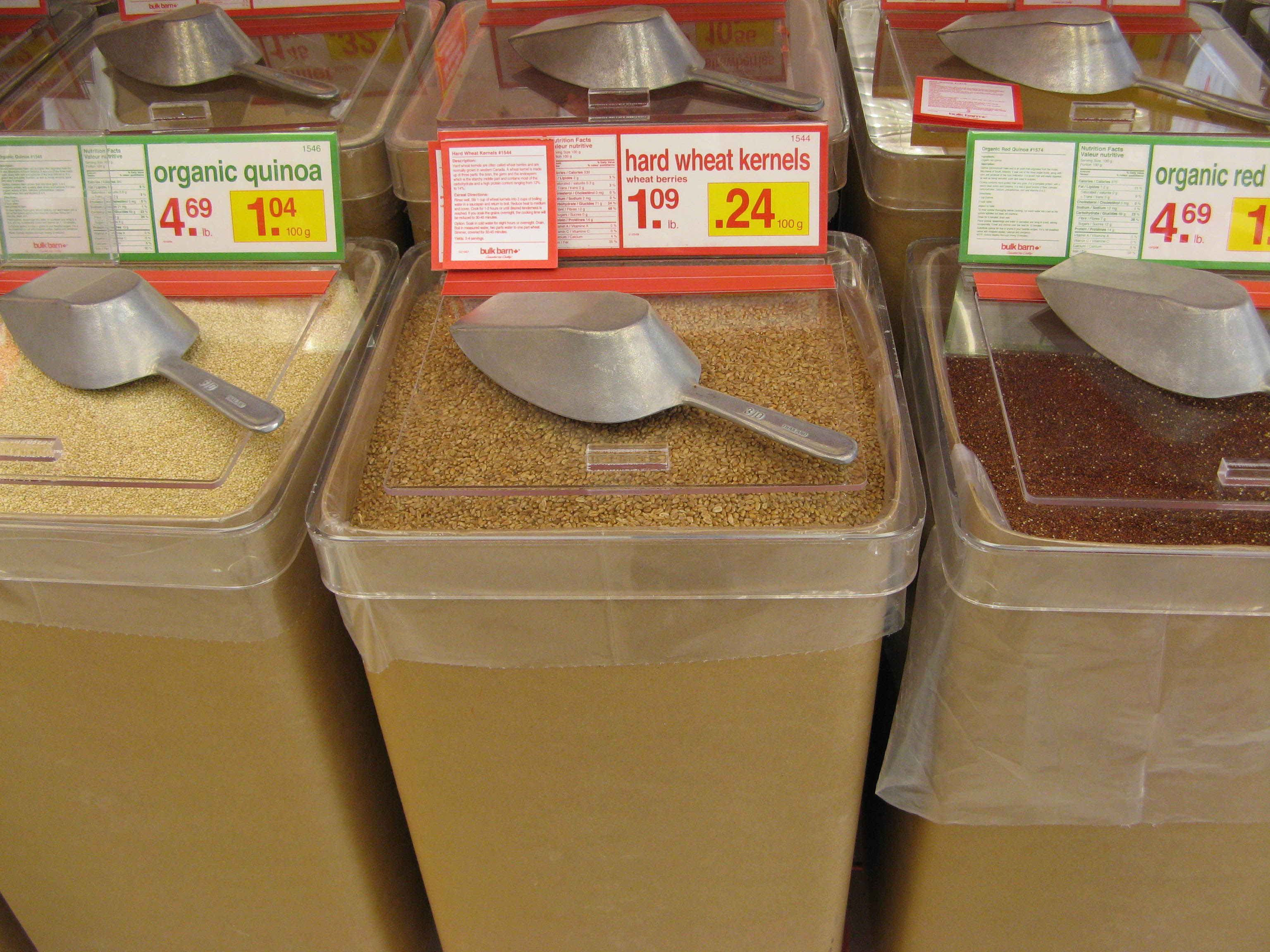A recent workshop taught me that people are quite confused when it comes to whole grain, unprocessed carbs. They just don’t know what they are, where to find them, and what they’re good for.
The whole grain survey
A few weeks back I gave a nutrition workshop and during the event I asked the attendees to come up with a list of unprocessed, whole grain carbohydrates they consume on a regular basis. Now, at this point, I’d like you to do the same.
Get out a piece of paper, take a minute, and write down 6 unprocessed whole grain carbs that you have in your house right now and eat on a regular basis. Seriously, go ahead. Put ’em down. And be specific.
Unprocessed, Whole Grain Food #1-
Unprocessed, Whole Grain Food #2 –
Unprocessed, Whole Grain Food #3 –
Unprocessed, Whole Grain Food #4 –
Unprocessed, Whole Grain Food #5 –
Unprocessed, Whole Grain Food #6 –
Ok now, let’s talk whole grains.
What’s a whole grain?
Interestingly, during the workshop discussed above, I learned something very important. And the lesson was this. Most people have no idea what experts are talking about when they recommend unprocessed, whole grain carb sources.
This was particularly eye-opening for me because I regularly encourage folks to do just that. In seminars. In articles. And in a few spots in Precision Nutrition V4.
This is because whole grain, unprocessed carbs offer the following benefits:
- They’re high in fiber, helping us maintain a healthy GI tract
- They’re slow to digest, helping us control blood sugar
- They’re loaded with vitamins and minerals, improving our nutrient density
- They’re satisfying, helping us control appetite
As a result of these benefits above, whole grain, unprocessed carbohydrate sources tend to be much better handled, even by those with naturally poor carbohydrate tolerance, than the more heavily processed starchy carbohydrate sources like breads, pastas, rices, crackers, and cereals.
That’s right, even if you don’t think you can “handle carbs”, you can probably eat a moderate amount of whole grain, unprocessed carbs. And not only can you “get away” with it. You’d probably benefit from including them.
Now that’s all good and fine. Yet, in my surveys of late, I’ve found that people don’t really understand what I mean when I recommend whole grain, unprocessed carbs. In fact, the top five foods listed in my workshop surveys were:
1) Store-bought whole wheat bread
2) Quaker quick oats
3) Whole wheat pasta
4) Whole grain crackers
5) Brown rice
In addition to these five staples, I also found that people regularly included white and sweet potatoes, “whole grain” breakfast cereals, and “whole grain” chips in their lists. Interesting.
The whole grain farce
Now, I’m not here to say that things like whole grain breads, crackers, and pastas are “bad for you.” Indeed, people are regularly eating foods that are much, much worse than these. Yet, I do think it important to note that when I recommend whole grain, unprocessed carbs, most of these foods don’t fit in. And they certainly don’t behave the same way in the body that unprocessed whole grains behave.
Now I know you’re about to give me your best “what you talkin’ about JB?” But hear me out.
Just because a food package says “whole grain,” that doesn’t mean the product is a whole grain food. I know, seems confusing at first. But bear with me. With the lax nutritional labeling standards we have nowadays, even foods like Frosted Flakes can qualify for the “whole grain” label because they’re adding small amounts of “whole grain corn” and “whole grain wheat” to the product.
Of course, the cover image doesn’t mention anything about the heavily processed ingredients including: sugar, high fructose corn syrup, processed rice, processed wheat, and a host of other additives and preservatives. Nope, the cover simply mentions what a wonderful source of “whole grains” and fiber this cereal is.
Also, and potentially more disturbing, is the fact that Krispy Kreme is jumping on the “whole grain” bandwagon, further diluting the meaning of “whole grain.” That’s right, THE Krispy Kreme is now offering a whole wheat, glazed donut.
Now, their corporate position suggests that these are healthier than non-whole grain donuts. And that can’t be a bad thing, can it? But seriously, how insulting does something have to get before our intelligence fights back?
Sure, there are folks that will try to assuage the guilt they associate with their donut addiction by suggesting that their addiction of choice now contains some “healthy stuff.” But I hope the rest of us see these for what they are. Deep fried, sugar coated, nutritionally empty fake foods with a little whole wheat sprinkled on top.
Did you know that according to today’s label allowances, many products making the “whole grain” claim contain as little as 1% whole grain? Cue up the Frosted Flakes ad.
Here’s another beauty. Many manufacturers color their breads, crackers, and snacks brown (often with molasses) so that their foods sorta look like whole grains. What an embarassment. And this just scratches the shady surface of the “whole grain” industry.
So, let’s be clear on one thing. When I recommend whole, unprocessed carb sources, I’m recommending unprocessed foods that, in their entirety, are comprised of whole grains. Not foods that are highly processed (like breads, cereals, crackers, snacks, etc.). And not foods that have a light sprinkling of processed grains – included for marketing purposes, not for health purposes.
What qualifies as a whole grain?
As a result of all the whole grain confusion I’m seeing, in Precision Nutrition V3 we decided to include notes on what qualifies as a healthy, whole grain, unprocessed carb.

Here’s an abbreviated list from PN V4:
- Plain full flake or steel cut oats
- Plain amaranth
- Plain quinoa
- Plan millet
- Plain wheat berries
- Plain barley
- Plain wild rice
Now, you’ve probably already cringed at the word “plain” prefacing each of these grains. Don’t fret. I use this because nowadays companies do their best to “spice up” these foods, usually to the detriment of the food’s natural health properties. So it’s important to do the “spicing up” at home.
Indeed, you can turn plain quinoa, wheat berries, barley, or amaranth into amazingly tasting dishes with these grains by using some of the tips, recipes, and flavor combinations shared in Gourmet Nutrition V2.
Also note, the preparation of whole grains is usually no more difficult than preparing rice. You can either throw them in a rice cooker and let them cook while you’re gone. Or you can throw them in water and let them simmer away until the water is absorbed by the grain.
Finally, if you’re not sure where to pick up your whole grains, grocery stores and supermarkets with bulk food sections usually have a decent selection. Further, specialty bulk stores like The Bulk Barn and a variety of health food stores also offer good selections of whole grains.
Can I eat all I want?
In a word, no!
Just because I’m extolling the virtues of whole grains in this article, that doesn’t mean you can eat all you want. These foods are still carbohydrate dense. So, understanding the goodness of grains doesn’t give you license to overeat them, and by extension, overeat calories and carbohydrates.
Instead, the Precision Nutrition principles still apply. Even when including whole grains, make sure to eat according to your body type. Also make sure to use nutrient timing. And finally, pay attention to your food sensitivities.
Whole grain recipes
Now that you’re all excited about whole grains, I’d like to refer you to a few whole grain recipes we share in Gourmet Nutrition V2.
Gourmet Nutrition V2
Banana Cream Pie Oatmeal – page 42
Pumpkin Pie Oatmeal – page 44
Quinoa, Apple, and Walnut Salad with Turkey Sausage – page 146
Roasted Garlic Barley Risotto – page 206
Fruity Cashew Quinoa – 208
Chunky Tomato Spelt – page 210
If you’ve already got a copy of GN V2, make sure to give these recipes some work. And if not, click here for GN V2.
Eat, move, and live…better.©
The health and fitness world can sometimes be a confusing place. But it doesn't have to be.
Let us help you make sense of it all with this free special report.
In it you'll learn the best eating, exercise, and lifestyle strategies – unique and personal – for you.




Share